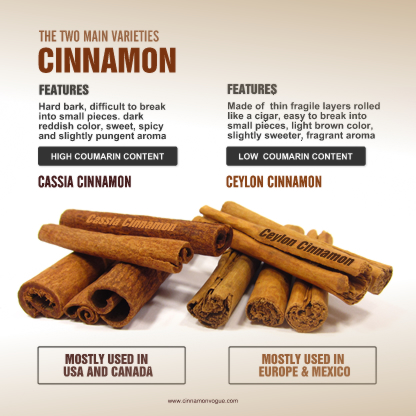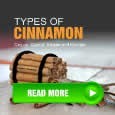 MEDIA GALLERY
MEDIA GALLERY




Features |
Cassia
|
Ceylon Cinnamon
|
Bouquet/Smell
|
Strong
|
Subtle Sophisticated
|
Color
|
Dark Red Brown
|
Light brown
|
Outer appearance
|
Very hard
|
Soft and crumbly
|
Inner filling
|
Hollow tube
|
Filled like a cigar
|
Taste
|
Spicy and strong flavor, milder aroma
|
Mild and sweeter taste, hints of Citrus and fragrant aroma
|
Grown in
|
China, Vietnam, Indonesia
|
Ceylon (Sri Lanka)
|
Other Names
|
Saigon Cinnamon
|
True or real Cinnamon
|
Coumarin Content
|
5%
|
0.004%
|
| Botanical Name | Cinnamomum Cassia
|
Cinnamomum Zeylanicum ( Latin name for Ceylon)
|
Cinnamon is a tropical evergreen tree whose leaves and inner bark is used to make Cinnamon oil and cinnamon sticks. Leaves from a wild cinnamon tree is harvested by growing the tree for two years then coppicing it. The next year, about a dozen shoots will form from the roots. The branches harvested this way are processed by scraping off the outer bark, then beating the branch evenly with a hammer to loosen the inner bark. The inner bark is then pried out in long rolls.
Only the thin (0.5 mm (0.020 in)) inner bark is used; the outer, woody portion is discarded, leaving meter-long cinnamon strips that curl into rolls ("quills") on drying. Once dry, the bark is cut into 5–10 cm (2.0–3.9 in) lengths for sale.
The bark must be processed immediately after harvesting while still wet. Once processed, the bark will dry completely in four to six hours, provided that it is in a well-ventilated and relatively warm environment.
A less than ideal drying environment encourages the proliferation of pests in the bark, which may then require treatment by fumigation. Bark treated this way is not considered to be of the same premium quality as untreated bark.
Cinnamon has been cultivated from time immemorial in Sri Lanka, and the tree is also grown commercially at Kerala in southern India, Bangladesh, Java, Sumatra, the West Indies, Brazil, Vietnam, Madagascar, Zanzibar, and Egypt.
Sri Lanka cinnamon has a very thin, smooth bark with a light-yellowish brown color and a highly fragrant aroma. In recent years in Sri Lanka, mechanical devices have been developed to ensure premium quality and worker safety and health, following considerable research by the Universities in that country led by the University of Ruhuna. According to the International Herald Tribune, in 2006 Sri Lanka produced 90% of the world's cinnamon, followed by China, India, and Vietnam. According to the FAO, Indonesia produces 40% of the world's Cassia genus of cinnamon.
Grading Cinnamon Sticks
Ceylon Cinnamon sticks from Sri Lanka is graded into 4 main categories as follows :
GRADE |
SIZE |
|---|---|
Alba |
less than 6 mm (0.24 in) in diameter |
| Continental | less than 16 mm (0.63 in) in diameter
|
C5 Special |
|
C5 |
|
C4 |
|
| Mexican | less than 19 mm (0.75 in) in diameter |
M5 |
|
M4 |
|
| Hamburg | less than 32 mm (1.3 in) in diameter
|
H1 |
|
H2 |
These groups are further divided into specific grades. For example, Mexican is divided into M00 000 special, M000000, and M0000, depending on quill diameter and number of quills per kg. Any pieces of bark less than 106 mm (4.2 in) long are categorized as quillings. Feathering's are the inner bark of twigs and twisted shoots.
Chips are trimmings of quills, outer and inner bark that cannot be separated, or the bark of small twigs. Ceylon cinnamon, using only the thin inner bark, has a finer, less dense, and more crumbly texture has more sophisticated smell compared to Cassia Cinnamon which has a much stronger (somewhat harsher) flavor than Ceylon cinnamon, is generally a medium to light reddish brown, hard and woody in texture, and thicker (2–3 mm (0.079–0.12 in) thick), as all of the layers of bark are used.
Due to the presence of a moderately toxic component called coumarin, European health agencies have recently warned against consuming large amounts of cassia. This is contained in much lower dosages in Ceylon Cinnamon due to its low essential oil content. Coumarin is known to cause liver and kidney damage in high concentrations. Ceylon cinnamon has negligible amounts of coumarin.The barks, when whole, are easily distinguished, and their microscopic characteristics are also quite distinct.
Ceylon cinnamon sticks (or quills) have many thin layers and can easily be made into powder using a coffee or spice grinder, whereas cassia sticks are much harder. Indonesian cinnamon is often sold in neat quills made up of one thick layer, capable of damaging a spice or coffee grinder. Saigon cinnamon and Chinese cinnamon are always sold as broken pieces of thick bark, as the bark is not supple enough to be rolled into quills.
















